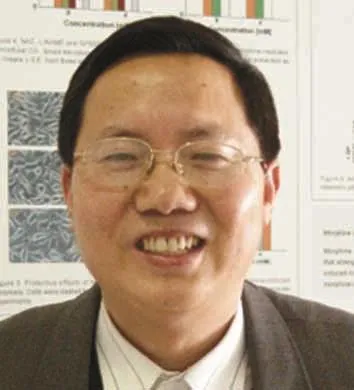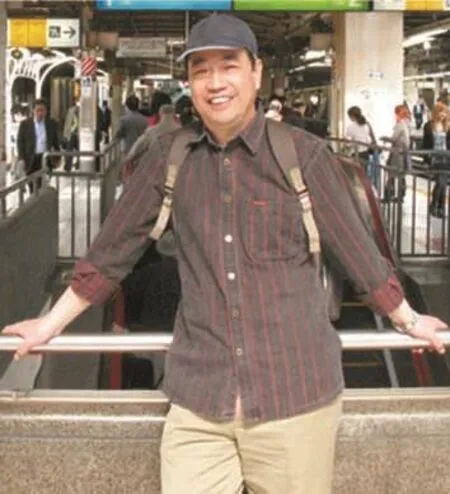专题4 抑郁、癫痫:行为学与细胞机制
李云峰
(军事医学科学院毒物药物研究所,北京 100850)
专题4 抑郁、癫痫:行为学与细胞机制
S4-1快速起效抗抑郁-焦虑的靶标策略与新药研究
李云峰
(军事医学科学院毒物药物研究所,北京 100850)

李云峰,博士,研究员,2006-2008年在美国西弗吉尼亚大学医学院作访问学者研究,目前为军事医学科学院毒物药物研究所研究室主任、博导、学科带头人。北京市“科技新星”(2005),军队优秀科技人才岗位津贴获得者(2011)。长期从事抗抑郁-焦虑药的靶标机制和新药创制研究。主持获得国家1.1类抗抑郁化药的临床批件2个,其中原创化学结构的SERT/5-HT1A/6多靶标新药羟哌吡酮具有快速起效、兼有增强认知、无性功能障碍等优势;发现系列抗抑郁中药并系统揭示其物质基础及其神经调控规律,获我国首个中药5类抗抑郁新药证书并上市(巴戟天寡糖胶囊,当年入选“国内十大重磅处方新药”,2012),为抑郁症治疗开辟了全新的物质类别。揭示了PDE4D剪接体与抑郁-认知行为的密切关系及分子细胞调控机制;揭示胶质细胞对抑郁-焦虑的调控机制,并在此基础上发现全新机制1.1类抗焦虑-抑郁候选新药YL-IPA08。以通讯/第一作者在J Neurosci,Neuropsychopharmacology,Br J Pharmacol,Neuropharmacology,Sci Rep等领域著名期刊发表SCI论文35篇;以第一完成人获北京市科技一等奖1项(2015),中华中医药学会科技一等奖1项(2014),军队科技进步二等奖1项(2012);累计获国内外授权专利23项。目前担任全国和北京市神经精神药理专业委员会常委,北京市神经科学学会常务理事、副秘书长、青年委员会主任委员,全军神经内科专委会青年委员会副主任委员,Front Pharmacol等多个SCI期刊副主编或编委。
目的在成功发现新药的基础上归纳新药研发的潜在靶标策略。方法与结果基于优化的多靶标单胺策略,发现2个1.1类抗抑郁化学新药并获得国家CFDA批准的Ⅰ~Ⅲ期临床批件,即盐酸羟哌吡酮(YL-0919)和盐酸阿姆西汀(071031B)。YL-0919是原创化学结构的小分子化合物,兼具5-HT重摄取抑制、5-HT1A部分激动和5-HT6激动作用,较临床一线药物具有靶标新颖、起效迅速、兼有增强认知作用、无性功能障碍等优势;071031B是5-HT/NE重摄取抑制剂度洛西汀的结构优化衍生化合物,具有更强效、肝毒性低、生物利用度高等优点。基于非单胺靶标策略,开展了胶质细胞上18 ku转位蛋白(TSPO)靶标机制和新药研究,采用TSPO敲除动物和病毒过表达技术发现,TSPO-/-与TSPO+/+小鼠虽对慢性应激具有相同的敏感性,但TSPO选择性激活剂AC-5216在野生型小鼠上快速(2~3 d)产生的抗焦虑、抗抑郁、促认知作用,且快速增强突触可塑性可能是其重要机制,而在敲除小鼠上无此作用。进而发现了新化学结构和新机制的1.1类抗焦虑-抑郁、抗PTSD候选新药YL-IPA08,并证实其具有快速抗抑郁-焦虑、促认知行为学活性及良好的成药性,其中TSPO及其介导的四氢孕酮释放是其抗PTSD、抗焦虑-抑郁行为的核心环节。结论提出单胺能快速起效抗抑郁的多靶标同向、多脑区协同的新药设计思路和靶标策略,提出介导快速抗抑郁效应的“单胺-非单胺长程反馈神经环路”潜在候选假说,为研发单胺能-非单胺能协同的抗抑郁药提供理论基础。
快速起效;抗抑郁药;羟哌吡酮;TSPO;YL-IPA08
S4-2记忆网络中的N-甲基-D-天冬氨酸受体
张丹参
(河北科技大学,河北石家庄 050018)

张丹参,教授,博士生导师。现任河北科技大学副校长。研究方向:神经药理学。学术兼职:中国药理学会常务理事,中国麻醉药理学专业委员会副主任委员,中国补益药药理专业委员会副主任委员,中国神经精神药理学专业委员会委员,河北省药理学会、神经科学学会、毒理学会副理事长,河北省侨联专家委员会副主任委员。全国医药类学术期刊《神经药理学报》主编。曾荣获全国优秀科技工作者、全国三八红旗手、河北省模范教师等荣誉称号。
摘要:N-甲基-D-天冬氨酸(NMDA)受体属谷氨酸离子型受体,其与突触的可塑性和学习记忆密切相关。中枢神经系统中与学习记忆相关的,如以胆碱受体、谷氨酸受体、腺苷A1受体等为代表的诸多受体及递质,以谷氨酸(Glu)/GABA为代表的氨基酸能神经通路,以长时程增强(LTP)等为代表的脑内神经电活动,以脑源性神经营养因子(BDNF)等为代表的基因蛋白遗传信息改变,甚至许多神经退行性疾病中Glu的神经毒性,等等,都与NMDA受体相关,通过NMDA受体功能的改变调控学习记忆功能,进而对整个中枢神经系统产生影响。换句话说,如果把学习记忆的信息传递系统看做一个庞大的信息网络,那么NMDA受体就是学习记忆相关神经网络中一个相对中心的关键位点。因此,以探讨NMDA受体在学习记忆错综复杂网络中的关联为切入点,以微观深入研究为基础、以宏观视野分析为引领,全方位评价NMDA受体在学习记忆网络中的作用,或许可以引领未来脑功能及相关疾病系统的研究。
关键词:N-甲基-D-天冬氨酸;受体;记忆
S4-3抑制星形胶质细胞Hsp90-GLT1的抗癫痫机制研究
许琪
(中国医学科学院基础医学研究所,北京协和医学院基础学院,中国医学院神经科学中心,北京)
许 琪,博士,中国医学科学院基础医学研究所研究员,“协和学者”特聘教授,中国医学科学院神经科学中心执行主任。国家自然科学基金“杰出青年基金”和中国青年科技奖获得者。近20年来从事精神分裂症、抑郁症、癫痫等重性脑疾病发生的分子机制与治疗靶点研究,现已在Nature,Nature Genetics,Nature Structural&Molecular Biology,JEM,Molecular Psychiatry,American Journal of Psychiatry,Biological Psychiatry等期刊发表通讯作者或第一作者论文60余篇。

摘要:大脑内的兴奋性神经递质"谷氨酸"的异常累积是导致癫痫发作的主要原因。星形胶质细胞可以通过谷氨酸转运蛋白1(GLT-1/EAAT2)来清除胞外谷氨酸,终止神经兴奋性传导。病理证据表明,GLT-1的“缺失”是导致谷氨酸异常累积的重要原因,但原因尚不清楚。本课题组近期的研究发现,致癫灶的星形胶质细胞中过量表达的Hsp90β通过将GLT-1募集到20S蛋白酶体的方式促进GLT-1的蛋白降解。Hsp90抑制剂能够阻止GLT-1的过度降解,显著提高GLT-1的蛋白水平,并增强星形胶质细胞对体外谷氨酸的清除能力。我们对颞叶癫痫模型小鼠开展的治疗性研究发现,Hsp90抑制剂17AAG具有显著的抗癫痫效果,长期用药可大幅降低自发性癫痫发作频率(平均抑制效果73.4%),提高无癫痫发作天数,同时能够缓解星形胶质细胞增生的病理现象。本工作拓展了癫痫发病的分子病理机制,也为颞叶癫痫等难治性癫痫的治疗提供了新的思路。
关键词:星形胶质细胞;癫痫;谷氨酸转运蛋白1
S4-4 Disturbance of cholinergic Grb2-associated-binding protein 1 signaling participate in the pathological process of cognitive dysfunction
TAN Chao1,LU Nan-nan1,SHAO Ling-xiao1,LIU Xiu-xiu1,2,PAN Yue1,LIU Yi-jie1,YU Fang-ying1, LU Ying-mei2,HAN Feng1
(1.College of Pharmaceutical Sciences,Zhejiang University,Hangzhou,China;2.School of Medicine,Zhejiang University City College,Hangzhou,Zhejiang,China)

韩 峰,教授,博士生导师;药学系主任,药理所副所长。基于脑微血管病理基础的神经精神疾病发病机制研究及药物靶标发现。已发表SCI论文50余篇,总影响因子逾260。作为通讯作者大部分工作发表在Cell Res,J Am Chem Soc,Antioxidants&Redox Signaling,J Pineal Res等杂志上。近5年论文总引用1460次,他引次数逾830次。近5年以通讯或第一作者发表SCI论文30余篇,影响因子8以上论文10余篇,单篇影响因子最高14.812。近年负责主持了国家自然科学基金重点国际合作研究项目、国家自然科学基金重大研究计划、国家重点研发计划重点专项、省部级重点项目等10多项科研项目。现担任J Pharmacol Sci副主编及多家国际刊物编委;入选“浙江省卫生高层次人才”、“钱江人才”、“浙江省151人才”。中国毒理学会理事;中国药理学会神经精神药理学专委会委员;中国药理学会心血管药理专委会委员;中国药理学会生化与分子药理学专委会委员;神经毒理专委会委员,浙江省毒理学会副理事长及秘书长等。获得中国药学会“施慧达杯”优秀论文一等奖,浙江省高校科研成果一等奖、浙江省自然科学学术奖二等奖及浙江省自然科学奖等。
S4-5 Effects of ketamine on mouse hippocampal inflammatory cytokines IL-6, IL-1β and TNF-α levels in acute and chronic administration models
LI Yan-ning1,SHEN Rui-peng1,2,WEN Ge-hua1,DING Run-tao1,DU Ao1,ZHOU Ji-chuan3,DONG Zhi-bin1, REN Xing-hua1,YAO Hui1,ZHAO Rui1,ZHANG Guo-hua1,LU Yan3,WU Xu1
(1.Department of Forensic Pathology,School of Forensic Medicine,China Medical University, Shenyang 110122,China;2.Wujiang District Branch of Suzhou Public Security Bureau, Suzhou 215200,China;3.Key Laboratory of Health Ministry in Congenital Malformation, the Affiliated Shengjing Hospital of China Medical University,Shenyang 110004,China)
Abstract:OBJECTIVEKetamine is an injectable anesthetic and recreational drug of abuse commonly used worldwide.Many experimental studies have shown that ketamine can impair cognitive function and induce psychotic states.Neuroinflammation has been suggested to play an important role in neuro⁃degeneration.Meanwhile,ketamine has been showed to modulate the levels of inflammatory cytokines. Therefore,we sought to investigate whether the effects of ketamine on the central nervous system is associated with the inflammatory cytokines.METHODSWe established acute(single or multiple intra⁃peritoneal injection)and chronic(six months daily intraperitoneal injection)ketamine administration models in C57BL/6 mice,evaluated the spatial recognition memory and emotional response by applying the Y maze test and open field test.We analyzed the changes of inflammatory cytokines interleukin-6(IL-6),interleukin-1β(IL-1β)and tumor necrosis factor-α(TNF-α)levels in mouse hippocampus,employing Western blot,quantitative reverse transcriptase-polymerase chain reaction(qRT-PCR)and immunohisto⁃chemistry.RESULTSKetamine induced spatial recognition memory deficit,reduced anxiety-like behav⁃iors in mice after chronic administration,and it was dose-dependent.Moreover,we found that ketamine could increase the levels of mouse hippocampal inflammatory cytokines IL-6 and IL-1β after single,multi⁃ple and long-term administration in a dose-dependent manner.However,the level of TNF-α expressed differently in mouse hippocampus under different conditions.Single administration of ketamine increased the level of TNF-α,whereas multiple and long-term administration decreased it significantly.We consid⁃ered that TNF-α might exist bi-directional regulatory pathway,which was associated with the dose and duration of ketamine administration.CONCLUSIONOur results suggest that the alterations of inflamma⁃tory cytokines IL-6,IL-1β and TNF-α levels may be involved in the neurotoxicity of ketamine.
Key words:ketamine;behavior;IL-6;IL-1β;TNF-α
S4-6 A network pharmacology approach to decipher the mechanisms of anti-depression of Xiaoyaosan formula
GAO Yao,TIAN Jun-sheng,QIN Xue-mei
(Modern Research Center for Traditional Chinese Medicine of Shanxi University,Taiyuan 030006,China)
Abstract:OBJECTIVEDepression is one of the prevalent and prominent complex psychiatric diseases and the number of depressed patients has been on the rise globally during the recent decades. Xiaoyaosan,as a famous Chinese herbal formula,has been widely used in depression patients for a long time.However,the therapeutic mechanisms remain uncertain because of difficulty of depression pathophysiology and the lack of bioinformatic approach to understand the molecular connection.METHODSIn this thesis,we applied a network pharmacology approach to explain the potential mechanisms between Xiaoyaosan and depression involved in oral bioavailability screening,drug-likeness assessment, caco-2 permeability,blood-brain barrier target recognition and network analysis.RESULTS66 active compounds in Xiaoyaosan formula with favorable pharmacokinetic profiles are predicted as active compounds for anti-depression treatment.Network analyses show that these 66 compounds target 40 depression-associated proteins including especially HTR2A,NR 3C1,MAOB,XDH and CNR2.These proteins are mainly involved in the neuroactive ligand-receptor interaction,serotonergic synapse, cAMP signaling pathways and calcium signaling pathways.CONCLUSIONThe integrated network pharmacology method is an effective approach to illustrate the anti-depression mechanisms of herbs, and this in silico approach can be applied in drug discovery.
Key words:network pharmacology;Xiaoyaosan formula;depression
S4-7 Baicalin treatment regulates hyperactivity of HPA axis and alters SIRT1 related inflammation in the hypothalamus in a model of depression
YU Hai-yang1,2,ZENG Min-jie1,FU Qiang1,MA Shi-ping1
(1.Department of Pharmacology of Chinese Materia Medica,China Pharmaceutical University,Nanjing 10009,China;2.Institute of Pharmacology,Taishan Medical University,Tai′an 210046,China)
Abstract:OBJECTIVEHyperactivityof hypothalamic-pituitary-adrenal(HPA)axis is an important aetio⁃logical risk factor for the development of depression.Previous studies have demonstrated that the phe⁃nolic monomer baicalin has antidepressant-like effects and decreases serum corticosterone levels. However,the mechanism by which baicalin regulates hyperactivity of HPA axis remains unclear.This work aimed to investigate the effects of baicalin on hyperactivity of HPA axis using the olfactory bulbect⁃omised(OBX)rat model of depression.METHODSAnimals were anaesthetised with 10%chloral hydrate(3.3 mL·kg-1,ip).Using disinfected surgical equipment,the skull covering the olfactory bulbs was exposed by a midline incision.Two burr holes(2 mm diameter)were drilled 8 mm anterior to the bregma and 2 mm lateral to the midline.Both olfactory bulbs were aspirated and the holes filled with glass ionomer cement.The scalp was sutured closed.Sham-operated rats underwent every surgical procedure except the aspiration of the bulbs.The animals received penicillin(8×105U)intramuscularly (0.2 mL/300 g)once per day for 3 d post-surgery to prevent infection,and were subsequently housed alone in polypropylene cages.The experiments continued after 14 d of rehabilitation.The following groups were used for experiments:sham-operated(underwent surgical procedure without aspiratedolfactory bulbs and administration of vehicle only),OBX-model(underwent every surgical procedure and administration of vehicle only),OBX-amitriptyline treated(10 mg·kg-1),and OBX-baicalin treatment (20 and 40 mg·kg-1).Amitriptyline and baicalin were dissolved in physiological saline.RESULTSWe examined how baicalin altered OBX-induced changes in serum glucocorticoid level as well as inflammatory responses,sirtuin 1(SIRT1)expression,and p65 acetylation in the hypothalamus.Similar experiments were performed to analyse the effects of baicalin on lipopolysaccharide-induced inflammatory responses inhypothalamus.CONCLUSIONOur results indicate that activation of the SIRT1 in the hypothalamus contributes to hyperactivity of HPA axis,which can be alleviated by baicalin.
Key words:baicalin;SIRT1;acetylated p65;inflammation;depression
Corresponding author:MA Shi-ping,E-mail:shipingma2014@163.com
专题5 5药物滥用:行为与分子生物学
S5-1 BDNF dependent Rac1 GTPase activation in the vmPFC contributes to aversive memory extinction by Arc-mediated GABAA receptor endocytosis
WANG Wei-sheng,JU Yun-yue,WANG Yu-jun,LIU Jing-gen
(Key Laboratory of Receptor Research,Shanghai Institute of Materia Medica,Chinese Academy of Sciences and Collaborative Innovation Center for Brain Science,Shanghai 201203,China)

刘景根,中国科学院上海药物研究所研究员、课题组长。2004年入选中国科学院“百人计划”和获得国家杰出青年科学基金,2007年入选“上海领军人才”。2011年获药明康德生命化学奖三等奖。现是中国科学院特聘研究员。主要从事阿片类药物耐受、成瘾的细胞和分子机理研究及低成瘾性阿片类镇痛药和戒毒药研究。现兼任中国神经精神药理专业委员会常务委员、中国生化和分子药理专业委员会委员,中国心理学会生理心理学会理事。上海市神经药理学专业会主任委员、上海市生理学会常务理事、上海市药理学会理事、上海市第二届禁毒专家委员会委员。河南省天然药物与免疫工程重点实验室学术委员会委员。Acta Pharmacological Sinica、药学学报(英文版)、中国药学(英文版)、中国药理学通报、神经药理学报、中国药物依赖性杂志、药学研究等杂志编委。
Abstract:Extinction of aversive memories has been a major concern in neuropsychiatric disorders such as anxiety disorders and drug addiction.The ventromedial prefrontal cortex(vmPFC)is important for memory extinction,but the underlying mechanisms are little known.Here,we report that extinction of conditioned place aversion(CPA),a type of aversive memory associated with drug withdrawal, required activation of Rho GTPase Rac1 in the vmPFC in a brain-derived neurotrophic factor(BDNF)-dependent manner,which triggers actin polymerization via Pak1-cofilin signaling pathway,leading to synaptic localization of activity-regulated cytoskeleton-associated protein(Arc)in the vmPFC.The synaptic Arc further determines GABAAreceptor(GABAAR)endocytosis that is necessary and sufficient for vmPFC long-term potentiation and CPA extinction.Thus,extinction of an aversive memory associated with drug withdrawal is intriguingly controlled by Rac1-dependent GABAAR endocytosis in the vmPFC, thereby suggesting therapeutic targets to promote extinction of the unwanted memory.
Key words:brain-derived neurotrophic factor;memory;GABAAreceptor
S5-2 Attenuation of opioid addiction in mice lacking aquaporin 4
LYU Yang1,2,JING Man-yi1,ZHAO Tai-yun1,PANG Chong1,WU Ning1,HU Gang2,SONG Rui1,LI Jin1
(1.Beiijing Institute of Pharmacology and Toxicology,Beijing 100850,China;2.Jiangsu Key Laboratory of Neurodegeneration,Department of Pharmacology,Nanjing Medical University,Nanjing 210029,China)

宋 睿,博士,军事医学科学院毒物药物研究所,副研究员,硕士生导师。本科毕业于第四军医大学临床医学系;硕博毕业于军事医学科学院。长期从事药物成瘾神经生物学机制及防复吸候选新药发现的研究。发现了多巴胺D3受体及二型大麻素受体调控成瘾的新机制,作为药效学负责人研制了具有自主知识产权的抗成瘾防复吸候选新药高选择性多巴胺D3R拮抗剂YQA14,已获得美国及日本等国的专利授权。作为课题负责人承担多项国家自然科学基金及省部级基金项目,发表SCI论文15篇,授权国际、国内专利2项。获得“中央军委后勤保障部优秀青年科技人才扶持对象”,“北京市科技新星”,“军事医学科学院人才战略工程后备人才”。现兼任中国药物滥用协会青年委员会副主任委员,中国女医师协会药学委员会专业委员等职。
Abstract:OBJECTIVETo examine the effects of aquaporin 4(AQP4)on opioid addiction and underlie the mechanism behind it.METHODS①In the heroin-induced self-administration(SA)experiment,we explored the role of AQP4 on heroin-induced psychological addiction.After the mice were trained to learn heroin-induced SA under a fixedratio1(FR1)reinforcement program for 7 d,we randomly switched the heroin doses to 0.00625,0.0125,0.025,0.05 or 0.1 mg·kg-1per infusion to counterbal⁃ance assignment design.In the end,all mice underwent extinction training and reinstatement testing.②In oral sucrose self-administration,5%sucrose solution was used for the mice and the procedures were similar to heroin SA.③In morphine-induced hyperactivity test,mice were habituated in the test apparatus for 30 min and then were given saline(10 mL·kg-1,sc)or morphine(10 or 20 mg·kg-1,sc)to record the locomotion for 1.5 h.④ For thein vivomicrodialysis experiment,mice were surgically implanted with intracranial guide cannula into nucleus accumbens(AP+1.4 mm,ML±0.9 mm,DV-3.8 mm from bregma).After 5 d of recovery from surgery,the mice were challenged by saline(10 mL·kg-1,sc) or morphine(10 mg·kg-1,sc),and then samples were collected every 20 min.RESULTSWe found that AQP4 deletion had no effects on sucrose-seeking and sucrose-taking,but it significantly attenuated heroin-taking and heroin-seeking behaviors in heroin self-administration.Besides these,AQP4 deletion had no effects on basal level of locomotion,but dramatically decreased morphine-induced hyperactivity. Furthermore,thein vivomicrodialysis studies showed that AQP4 deficiency inhibited morphine (10mg·kg-1,sc)-induced elevation of extracellular dopamine levels in nucleus accumbens in mice.CONCLUSIONOur present findings demonstrate that AQP4 was potentially involved in the properties of opioid rewarding by inhibiting dopamine release in nucleus accumbens(NAc).
Key words:aquaporin 4;opioid addiction;hyperactivity;nucleus accumbens3.Institute of Psycopharmacology,Central Institute of Mental Health,University of Heidelberg, 68159 Mannheim,Germany;4.Departments of Behavioral Medicine&Psychiatry and Physiology &Pharmacology,West Virginia University Health Sciences Center,Morgantown,WV 26506-9137, USA;5.The Florey Institute of Neuroscience and Mental Health,University of Melbourne, Parkville,Victoria 3010,Australia)
S5-3 Brucine N-oxide reduces ethanol intake and preference in alcohol-preferring Fawn-Hooded rats
LIANG Jian-hui1,2,WEI Shou-peng2,3,LI Yu-ling2,GONG Qi2,WANG Yan-ting2,LIANG Hui2, LIU Qing2,ZHANG Han-ting4,CHEN Feng5,Andrew J LOWRENCE5
(1.Department of Molecular and Cellular Pharmacology,School of Pharmaceutical Sciences,2.Department of Pharmacology,School of Basic Medicine Sciences,Peking University,Beijing 100191,China;

LIANG Jian Jian-hui ui,MD.,PhD.,Professor of neuropsychopharmacology and Psychiatrist, Department of Molecular and Cellular Pharmacology,School of Pharmaceutical Sciences, Peking University.He served as a fellow in Toyama Pharmaceutical and Medical Univer⁃sity,Japan and visiting scientist in Howard Florey Institute,the University of Melbourne, Australia.At present,He has some academic positions:(1)Founder/regular member in Asian Pacific Society for Alcohol and Addiction Research(APSAAR);(2)Secretary-General of Neuropyschoharmacological Division,Chinese Pharmacological Society(CPS);(3)Vice Chair of Neuropsychopharmacological Division,Beijing Pharmacological Society(BPS); (4)Deputy Chief Editor onMetabolic Brain Disease.His laboratory has focused on neuro⁃ psychopharmacological research,including:(1)Behavioral plasticity induced by psychoactive substance and chaperone-mediated opioid addiction in rats,mice,and zebra fishes;(2)Anti-alcoholism of extracts,fractions and compounds from traditional Chinese medicine and the mechanism underlying their pharmacological profiles in alcohol-preferring rats and mice;(3)A new model of comorbidity between depression and anxiety induced by LIANG′s contextual-stress box and the pathophysiological mechanisms in mice.
Abstract:OBJECTIVEThe alcoholism-related social problems have burdened the public health heavily. A better therapy for alcohol dependence as a chronic brain disease is highly required and interests the scientists worldwide.Our group has focused on screening the right drug with low toxicity and a sound curative effect from traditional Chinese medicine.METHODSAlcohol-preferring Fawn-Hooded(FH/ Wjd)rat was used as an animal model of alcoholism to evaluate the effects of brucine N-oxide(BNO), an alkoloid naturally existing in the seeds of Strychnos nux-vomica L,on the alcohol-drinking behaviors. Furthermore,its adverse action and toxicity were investigated.RESULTSTreatment with BNO at the doses of 30,50 and 70 mg·kg-1reduced the voluntary alcohol consumption and preference dosedependently and selectively without altering their water intake,total fluid intake,food consumption, body weight as well as sucrose preference.Remarkably,70 mg·kg-1of BNO did suppress the deprivationinduced elevation of alcohol ingestion.Moreover,BNO used at the same doses as above had no influence on locomotion in an open field test and could not result in the place preference effect.CONCLUSIONTaken together,BNO is of some significant pharmacological profiles to inhibit symptoms of alcohol dependence with high safety,and thence may be a potential pharmacotherapy.
Key words:brucine N-oxide;ethanol
Corresponding author:LIANG Jian-hui,E-mail:liangjh@bjmu.edu.cn
S5-4新型磷酸二酯酶特异性抑制剂的发现及识别机制
赖增伟,吴德燕,张天华,黄仪有,李 哲,吴一诺,罗海彬(中山大学药学院,广东广州 510006)

罗海彬,博士、教授、博士生导师,中山大学药学院科研副院长,广东省药物化学“珠江学者”特聘教授,国家自然科学基金优秀青年基金获得者,中国药学会-施维雅青年药物化学奖获得者。1999年于厦门大学获学士学位;2005年于香港浸会大学获博士学位;2006年12月中山大学"百人计划"引进为药学院副教授;2011年12月晋升为教授,2015年获得国家自然科学基金优秀青年基金支持,2016年入选广东省药物化学“珠江学者”特聘教授。罗博士主要从事磷酸二酯酶(PDE)的药物化学和结构生物学等方面的研究,如抗老年性痴呆、肺动脉高压、糖尿病、哮喘等药物靶标结构生物学和发现研究,重点构建靶标PDE全亚型的药物筛选体系,并进行相关的药物分子设计、有机合成、药效学和作用机制研究。2000年以来,在Cell,J Med Chem,Chem Commun,Org Lett,J Chem Theory Comput,Biochem Pharm,J Chem Inf Model等国内外杂志发表110多篇论文。已主持5项国家级、7项省部级和两项市局级项目,6项发明专利授权和2项PCT专利。
摘要:磷酸二酯酶(PDE)通过催化水解细胞内第二信使(环磷酸腺苷cAMP,或环磷酸鸟苷cGMP),以降低细胞内cAMP或cGMP的浓度,从而中止这两个第二信使所传导的生理作用。PDEs作为新型的药物作用靶点,参与多种疾病的治疗,已成为新药研发的重要靶点。截至目前,已有多个PDE抑制剂药物上市(PDE5:5个,治疗性功能障碍和肺动脉高压;PDE4:3个,治疗慢性阻塞性肺病等),其中最出名的案例是用于治疗男性勃起功能障碍和肺动脉高压的PDE5抑制剂西地那非。然而,低选择性是这些PDE抑制剂的主要缺陷。近期我们针对PDE4,5,8,9和10等亚型,通过基于结构的药物分子设计,合成并发现多类高选择性的抑制剂。如,1)合成近150个PDE9抑制剂,从中发现抑制效应最强的高选择性先导结构3r。3r(IC50=0.6 nmol·L-1,对PDE1选择性为788倍),活性和选择性均明显优于临床Ⅱ期的辉瑞抑制剂PF-04447943。通过晶体结构分析,发现3r与PDE9特有残基Y424形成氢键,是其具有高倍选择性的结构基础,这为PDE9高选择性抑制剂提供了新的设计策略。此外共晶结构还揭示3r和A452形成一个氢键,而PF-04447943未显示这种结合模式。通过设计与A452形成氢键,可提高化合物的抑制效应。2)合成近100个多个PDE5抑制剂,从中发现抑制剂从中发现抑制效应最强的高选择性先导结构1610。1610(IC50= 5.0 nmol·L-1,对PDE6选择性为100倍)的抑制活性与辉瑞药物西地那非相当,但选择性均明显优于西地那非(对PDE6选择性为2~3倍),动物实验也显示该类药物的抗动脉高压效果明显优于对照药物西地那非。通过分子模拟分析,发现1610进入靶标结构的Q2口袋,是1610具有100倍选择性的结构基础,这为PDE5高选择性抑制剂提供了新的设计策略。
关键词:磷酸二酯酶;抑制剂
S5-5 Protective effects of puerarin on alcohol-induced oxidative injury in PC12 cells
LU Jie*,WEI Zheng-jie*,ZHU Jia-hui,LONG Yue-zhou,WANG Xiao-dan
(Institute of Pharmacology,School of Pharmaccutical Sciences,Taishan Medical University,Tai′an 271016,China)
Abstract:OBJECTIVEThe aim of this study was to investigate the protective effect of puerarin on alcoholtoxicity in rat pheochromocytoma cell line(PC12).METHODSThe PC12 cells were incubated with different concentrations of puerarin in advance.The protective effects of the puerarin on alcohol induced PC12 cell impairment were evaluated according to the following approach:the viability of PC12 cell was determined by MTT assay and the impairment level was evaluated by analysis the leakage content of the lactate dehydrogenase(LDH).The cell apoptosis degree and the pro-apoptotic p53 protein expression were measured by flow cytometry.RESULTSAlcohol significantly impaired PC12 cell viability(P<0.05),and increased LDH leakage(P<0.05),induced cell apoptosis and upregulated expression of p53(P<0.05). While Puerarin significantly reversed these changes(P<0.05).CONCLUSIONPuerarin might exert protection effect against ethanol-induced neurotoxicity via inhibition the expression of p53 protein.
Key words:puerarin;alcohol;PC12;apoptosis;p53 protein
Corresponding author:WANG Xiao-dan,E-mail:xdwang@tsmc.edu.cn
*Co-first author.
S5-6 Protective effect of gingerol dropping pills against alcoholic liver injury in mice
LI Li,ZHANG Zhi-yuan,QI Si-jia,GAO Yong-feng,WANG Lei
(Institute of Pharmacology,Taishan Medical University,Tai′an 271016,China)
Abstract:OBJECTIVETo prepare gingerol dropping pills and to investigate its protective effect on alcoholic liver injury.METHODSThe prescription was selected by orthogonal design method and the effect of the option and ratio of ground substance,the temperature of drug.The hardness,circular degree,the tail formation and the dissolution time were studied.Totally 40 KM mice were randomly divided into control group,model group,gingerol dropping pill group(400 mg·kg-1·d-1)and positive control group(bifendate,150 mg·kg-1·d-1)of 10 mice each.The mice from the model and two drug groups were administrated with liqueur〔0.15 mL/(10 g·d)〕daily by gavage for 3 weeks,Two hours later,drug group mice were treated corresponding gingerol dropping pill and bifendate.Meanwhile,the control group were gavaged same amount of normal saline.Finally,when the model of acute alcoholic liver injury was established on the 22stday,Biochemical indicators of ocular blood in mice were observed. We also observed the change of liver morphology.RESULTSUnder optimum conditions,we can obtain dropping pills having circular shape,touching with hardness and short dissolution time.Compared with the control group,the levels of alanine transaminase(ALT),glutamic-oxaloacetic transaminase (AST)and malondialdehyde(MDA)in model group were obviously increased(P<0.01),While the activity of Superoxide dismutase(SOD)were decreased.In addition,In model group,mice liver disorders, hepatic lobule fusion,accompanying a large number of patchy sample liver cell vacuoles,various sizes of fat vacuoles appeared in cytoplasm and inflammatory cell infiltration were visible around the central vein.On the contrary,compared with the model group,drug groups attenuated or even reversed hepatic pathological changes.Form gingerol dropping pill group,an increase in hepatic SOD activity and serum ALT and AST activities were found and a significant decrease in hepatic MDA content were also observed(P<0.01).CONCLUSIONThe prescription of gingerol dropping pills was reasonable,and the preparation process was simple.Gingerol dropping pills can protect liver from alcoholic liver injury to some extend,and the mechanism may be related to its antioxidant effect.
Key words:gingerol dropping pills;alcoholic liver injury;antioxidation
Foundation item:The project supported by College Students Of Science and Technology Innovation Project of Tai′an City(2015D064);and the National College Students′Innovative and Entrepreneurial Training Project(201510439078)
Corresponding author:WANG Lei,E-mail:wang.lei1118@163.com,Tel:13105380208
S5-7 Overexpression of SIRT6 prevents hypoxia-induced apoptosis in osteoblast cells
WANG Jin-tao,YIN Xi-ya,GAO Shan,ZHOU Lu
(Department of Sports Medicine,Taishan Mecical University,Tai′an 271000,China)
Abstract:OBJECTIVETo investigated the role of SIRT6 in the survival of osteoblast cells against hypoxia stimulus as well as the underlying mechanism.METHODSMC3T3-E1 osteoblast cells were used.Apoptosis was induced by hypoxic treatment.MC3T3-E1 cells were transfected with adenovirus SIRT6.For SIRT6 silencing experiment,the transfection of cells were done using three siRNA duplexes directed at different regions of SIRT6 or scrambled siRNA pool.The relative levels of SIRT6 mRNA were quantifiedby using real-time PCR.Western blotting experiments were done after the specific treatment and sample collection.MTT assay was used to estimate cell viability.Caspase 3/7 activity was assayed.RESULTSThe expression of SIRT6 mRNA appeared to be markedly down-regulated in the hypoxia-treated group compared to the matched normal group.Meanwhile,western blotting analysis revealed that the expression of SIRT6 level was markedly down-regulated in hypoxia-treated group at protein level.SIRT6 level was effectively down-regulated by the transfection of SIRT6 siRNA,and significantly enhanced by SIRT6 overexpression.Compared with the control group,SIRT6 overexpression could significantly increase cell viability,and significantly decrease the percentage of apoptotic cells and the activity of caspase 3/7 in response to hypoxia treatment.By contrast,SIRT6 knockdown via treatment with SIRT6 siRNA exhibited the opposite phenotype.CONCLUSIONThese results suggest that SIRT6 plays a protective role in hypoxia-induced apoptosis in MC3T3-E1 cells,and that strategies might be beneficial for the treatment of ischemic bone disease.
Key words:SIRT6;hypoxia;apoptosis;osteoblast
Foundation item:The project supported by grants from Shandong Provincial Natural Science Foundation,China(ZR2014CQ037);National Training Programs of Innovation and Entrepreneurship for Undergraduates,China(201610439244);and National Natural Science Foundation of China(81400182)
S5-8芦荟多糖对实验性口腔溃疡大鼠NF-κB和MMP2表达的影响
王哲哲,张 雪,高永峰
(泰山医学院药学院,山东泰安 271016)
摘要:目的通过建立口腔溃疡大鼠模型,探讨芦荟多糖治疗口腔溃疡的相关机制。方法SD大鼠随机分5组,空白对照组、模型对照组、芦荟多糖100,200和400 mg·kg-1治疗组。除空白对照组外,其余各组大鼠采用50%冰醋酸造模,芦荟多糖100,200和400 mg·kg-1治疗组给予芦荟多糖进行干预,空白对照组和模型对照组给予生理盐水,连续给药7 d。计算造模后第4和第7天的溃疡面积;Western-blot测定实验大鼠口腔组织中NF-κBp65和MMP2表达水平。结果芦荟多糖各剂量组均可显著降低造模后第4和第7天的溃疡面积(P<0.05);芦荟多糖组可降低模型大鼠口腔溃疡组织中NF-κBp65的表达水平(P<0.05),对MMP2表达水平有一定抑制作用但未有统计学意义。结论芦荟多糖具有良好口腔溃疡治疗作用,其机制与抑制NF-κB炎症通路有关。
关键词:芦荟多糖;口腔溃疡;炎症;核因子-κB;基质金属蛋白酶2
通讯作者:高永峰,E-mail:13583830327@163.com,Tel:13583830327
S5-9 Screening of active ingredients of Taohong Siwu Decoction on platelet membrane receptor
GUO Chun-yan,WU Xin,CHEN Shuang,GAO Yuan-yuan,WAN Ye
(Hebei North University,Zhangjiakou 075000,China)
Abstract:OBJECTIVETo screen the active ingredients preventing platelet aggregations from Taohong Siwu Decoction.METHODSFresh blood from healthy adult volunteer was collected with vacuum tube for preparation of platelet suspension.Platelet suspension was incubated with Taohong Siwu Decoction forone hour at 37℃,then centrifuged.The precipitate was washed and desorbed with buffer solutions. The differences of chemical constituents between incubated and unincubated were identified with high performance liquid chromatography-diode array detector.RESULTSAccording to the chromatograph at 254 nm,at least three kinds of different components were detected in Taohong siwu decoction before and after incubated with platelet.CONCLUSIONPlatelet suspension can be used for screening active ingredients on platelet membrane receptor from the traditional Chinese medicine.
Key words:Taohong Siwu Decoction;blood platelet;HPLC;DAD
Corresponding author:GUO Chun-yan,E-mail:guochy0311@163.com,Tel:18931316689
S5-10丹参酮ⅡA对心血管系统的药理作用及其新剂型研究进展
侯文书,张 力
(河北北方学院药学系,河北张家口 075000)
摘要:目的本文综述近几年来丹参酮ⅡA对心血管系统的药理作用及其开发的新剂型研究进展。方法以近几年来国内外关于丹参酮ⅡA的研究为基础,对丹参酮ⅡA对心血管系统的药理作用及其新剂型研究进行分析和总结。结果丹参酮ⅡA在心血管系统方面具有抗动脉粥样硬化,抗心肌缺血,抗心律失常,修复血管内皮细胞,改善冠状动脉血液循环等作用,但丹参酮ⅡA有口服吸收差,生物利用度低的缺点,为改善丹参酮ⅡA的现状,需要制备丹参酮ⅡA新剂型,主要有注射用微乳,微球,固体分散体,脂质体,纳米粒等。结论丹参酮ⅡA在心血管系统方面发挥重要作用,新剂型的开发使丹参酮ⅡA在治疗心血管疾病发挥更大的药用价值,为进一步研究提供理论指导。
关键词:丹参酮ⅡA;心血管疾病;剂型
S5-11荷叶碱在大鼠体内的吸收、分布、代谢和排泄研究
王福刚,曹 娟,侯雪芹,曲晓兰,张继国
(泰山医学院,山东泰安 271016)
摘要:目的荷叶碱为荷叶中的主要活性成分,是一种具有调节血脂和治疗肥胖相关疾病的阿朴啡类生物碱。为了更好地指导临床用药,我们建立了荷叶碱在血浆及各组织匀浆中的定量测定方法,并对其在大鼠体内的吸收、分布、代谢和排泄进行了深入研究。方法大鼠静脉和灌胃给予荷叶碱0.2和10 mg·kg-1,在不同时间点收集血浆和组织,以盐酸巴马汀为内标,HPLC-MS法测定给药后荷叶碱在血浆和组织中的浓度。大鼠灌胃给予荷叶碱10 mg·kg-1,在不同时间点收集尿液和粪便,经处理后HPLC-MS法测定给药后荷叶碱在尿液和粪便中的浓度。结果空白血浆中荷叶碱在2~2000 ng·mL-1浓度范围内呈良好的线性关系,在血浆中绝对回收率为87.5%,样品在长期储存过程中能保持稳定。荷叶碱的绝对生物利用度较低为(1.9± 0.8)%。在体内分布中肾>脾>肝>心>肺>脑。荷叶碱在体内主要以原形存在,尚未发现其代谢产物;荷叶碱主要通过肾排泄(80.7%)。结论本研究建立了便捷而且有效定量测定大鼠血浆中荷叶碱的方法,并对荷叶碱在大鼠体内的吸收、分布、代谢和排泄进行了深入研究,为临床应用该药提供了理论依据。
关键词:荷叶碱;药动学;分布;代谢;排泄
S5-12抗坏血酸插层铁锆复合氧化物的制备及缓释性能评价
杨玉洁,孙凡荣,张毅伟,张忠义,张庆乐,王 浩
(泰山医学院,山东泰安 271016)
摘要:目的抗坏血酸是一种水溶性维生素,在治疗坏血病,预防癌症、心脏病和动脉粥硬化等方面具有较好的疗效,将其制成缓释剂型能降低临床上频繁给药带来的健康风险。铁锆双金属氧化物是一种性能优良的新型缓释材料,通过控制其制备工艺可提高该材料对抗坏血酸负载率和缓释性能。方法首先,采用松针水提液为绿色溶剂经化学沉淀法合成铁锆复合氧化物,以抗坏血酸负载率为评价指标,利用响应曲面法对铁锆复合氧化物的制备工艺进行优化。其次,利用体外实验评价抗坏血酸插层铁锆复合氧化物的缓释效果。最后,利用动物实验评价了该材料的生物有效性。结果与结论首先,在100 mL松针提取液中加入0.01 mol的氯化铁和氯氧化锆(铁锆摩尔比为8∶1)、0.5 g十六烷基三甲基溴化铵,60℃持续搅拌1 h后调整溶液的pH值为9.5,105℃下烘干24 h时,制备的铁锆氧化物性能良好。0.1 g铁锆复合氧化物对50 mL浓度为50 mg·L-1抗坏血酸的最大负载率为94.10%。其次,抗坏血酸插层铁锆复合氧化物在模拟胃液和肠液中的最大缓释时间为7.5 h,具有较好缓释性能。最后,铁锆复合氧化物对小鼠基本没有急性毒性,适宜作为抗坏血酸的缓释载体材料。
关键词:铁锆氧化物;抗坏血酸;松针提取液;缓释
基金项目:国家级大学生创新创业计划(201610439137)
S5-13芍药苷对异丙肾上腺素诱导大鼠心肌重构的干预作用
徐晓燕,王 薇,王 蕾,陈 伟,高永峰
(泰山医学院药学院,山东泰安 271016)
摘要:目的通研究芍药苷(PEF)对异丙肾上腺素(ISO)诱导大鼠心肌重构的干预作用,并探讨可能的作用机制。方法雄性SD大鼠32只,随机分成4组,即对照组、模型组、芍药苷低剂量组、高剂量组(40,80 mg·kg-1),模型组和高、低剂量组连续皮下注射ISO(5 mg·kg-1)1周,对照组注射等比例生理盐水;造模同日起,高、低剂量组灌胃芍药苷,对照组和模型组灌胃等体积的生理盐水,连续14 d。末次给药后30 min,水合氯醛麻醉大鼠,腹主动脉取血测定羟脯氨酸;处死大鼠,取出心脏分离左心室并称重,测定左心室指数;Masson染色观察组织中心肌纤维化程度;心肌匀浆测定组织超氧化物歧化酶(SOD)、丙二醛(MDA)及Ⅰ型胶原蛋白的含量。结果模型组血清羟脯氨酸、左心室指数及心组织MDA、I型胶原蛋白含量均高于对照组(P<0.05),芍药苷给药组均低于模型组(P<0.05)。在Masson染色中,模型组心肌组织中的胶原明显增加;芍药苷低、高剂量组心肌组织中胶原纤维减少,不同剂量心肌组织胶原纤维减少不同,表现出对ISO引起大鼠心肌纤维化的干预作用。模型组大鼠组织SOD的活力降低;而芍药苷高、低剂量均可明显提高SOD活性模型组。结论芍药苷对ISO致大鼠心肌重构具有一定的干预作用,其作用机制可能与抗氧化作用有关。
关键词:芍药苷;心肌重构;异丙肾上腺素
基金项目:山东省高等学校科技计划(J14LM52);山东省中医药科技发展计划(2015-249);山东省医药卫生科技发展计划(2015WS0103)
S5-14 Primary culture and identify of cerebral cortical astrocytes from Sprague-Dawley rats
ZHANG Hai-wei1,WU Chun-yang1,ZHANG Dan-shen2
(1.Department of Phrmacy,Hebei North University,Zhangjiakou 075000,China;2.Hebei University of Science and Technology,Shijiazhuang 050000,China)
Abstract:OBJECTIVETo establish a method for primary cultured and iden-tified Sprague-Dawley (SD)rats cerebral cortical astrocytes.METHODSCerebral co-rtex of SD neonatal rats within 24 h was taken with stereo microscope and was cut topieces(1 mm3),digested by Accutase and 0.1%DNAase (37℃,15 min),anddispersed cell suspension was made by mechanical method and filtered.The fibroblast cells and microglia were removed through differential adhesion and sha-ke.Passaged cells were identified by immunofluorescent with anti-Glial fibrillaryacidic protein(GFAP)antibody.RESULTSThe astrocytes of rats cerebral cortex were cultured in this method,which had a large number of cells,good activity,high purity,abundant and elongated cell processes,and were interwoven into a network,showing a typical and good growth state.The third generation of the cells comprised>95%astrocytes.CONCLUSIONThis simple and reliable cultivation method of astrocyte from rat cerebral tissue is established with high purity,and in a good growth condition.
Key words:astrocytes;primary culture;identify
S5-15 Effect and mechanism of persimmon leaf flavonoid treatment of experimental oral ulcer
WANG Shuo,ZHANG Yong-li,HAO Mai-ling
(School of Stomatology of Taishan Medical University,Tai′an 271000,China)
Abstract:OBJECTIVETo explore the therapeutic effect and its mechanism of persimmon leaf flavonoids(PLF)on rats with oral ulcer.METHODSThe oral ulcer model was induced by acetic acid, was used for intervention of Guilin watermelon frost and different dose(20,40 and 80 mg·kg-1)of PLF. Ulcer area was calculated on the fourth and the seventh day after injury;the changes of superoxide dismutase(SOD)and malondialdehyde(MDA)in serum and ulcer tissues were observed;the level of tumor necrosis factor alpha(TNF-alpha)in ulcer tissue was measured.To observe the pathological morphological changes of H-E staining.RESULTSGuilin watermelon frost and PLF(40 and 80 mg·kg-1) can reduce the ulcer area(P<0.05);PLF(20,40 and 80 mg·kg-1)can increase the activity of SOD and decrease the content of MDA in serum and ulcer tissue(P<0.05);Guilin watermelon frost and PLF could significantly decrease the levels of TNF-alpha in ulcer tissue(P<0.05),and improve the inflammatory infiltration of ulcer tissue.CONCLUSIONPLF has certain therapeutic effects on oral ulcer induced by acetic acid,and the mechanism may be related to improve oxidative damage and reduce inflammatory reaction.
Key words:persimmon leaf flavonoids;oral ulcer;oxidative stress;inflammation
Foundation item:The project supported by National Undergraduate Training Program for Innovation and Entrepreneurship(201510439015)
Corresponding author:ZHANG Yong-li
S5-16玉米须水提物对自发性高血压大鼠血小板聚集功能的影响
秦梦瑶,王 慧,曲晓兰,杜宁宁,朱 超,谭 瑞,周延萌,张芳芳,赵晓民
(泰山医学院药理学研究所,山东泰安 271016)
摘要:目的研究玉米须水提物(AECS)对自发性高血压大鼠血小板聚集功能的影响和机制。方法自发性高血压大鼠随机分为模型组、AECS 5和15 g·kg-1组,WKY大鼠作为正常对照组,各组灌胃给药,连续25 d。第25天取大鼠肝素抗凝血制备富血小板血浆,比浊法检测ADP和胶原诱导的血小板最大聚集率变化,并测定血浆总抗氧化能力、谷胱甘肽和血管紧张素Ⅱ水平。结果与WKY组比较,模型组大鼠ADP(3和10 μmol·L-1)和胶原(4 μg·mL-1)诱导的血小板最大聚集率增高,血浆总抗氧化能力和谷胱甘肽水平降低,血管紧张素Ⅱ水平增高;与模型组比较,AECS 5和15 g·kg-1组大鼠在上述浓度ADP和胶原诱导的血小板最大聚集率降低,血浆总抗氧化能力和谷胱甘肽水平增高,血管紧张素Ⅱ水平下降。结论玉米须水提物可抑制自发性高血压大鼠的血小板聚集功能,机制与降低血管紧张素Ⅱ水平和抗氧化应激有关。
关键词:玉米须;高血压;大鼠;血小板;聚集;氧化应激;血管紧张素Ⅱ
基金项目:国家级大学生创新创业训练计划项目(201610439111);国家自然科学基金(81173061);泰山地产中药研发协同创新中心基金(zd099);山东省自然科学基金(ZR2014HQ007);山东省政府“泰山学者海外特聘专家”专项基金
通讯作者:赵晓民,E-mail:xmzhao@tsmc.edu.cn
S5-17玉米须水提物对自发性高血压大鼠的降压作用
王 慧,秦梦瑶,曲晓兰,杜宁宁,朱 超,谭 瑞,周延萌,张芳芳,赵晓民
(泰山医学院药理学研究所,山东泰安 271016)
摘要:目的研究玉米须水提物(AECS)对自发性高血压大鼠的降压作用和机制。方法自发性高血压大鼠随机分为模型组、AECS 5和15 g·kg-1组,WKY大鼠作为正常对照组,各组灌胃给药,连续25 d。每5 d监测鼠尾血压变化,第25天取血浆测定总抗氧化能力、谷胱甘肽和血管紧张素Ⅱ水平。结果与WKY组比较,模型组大鼠收缩压和舒张压增高,血浆总抗氧化能力和谷胱甘肽水平降低,血管紧张素Ⅱ水平增高;与模型组比较,AECS 5和15 g·kg-1组自第5天开始收缩压和舒张压均下降,持续至25d,血浆总抗氧化能力和谷胱甘肽水平增高,血管紧张素Ⅱ水平下降。结论玉米须水提物对自发性高血压大鼠有降压作用,机制与降低血管紧张素Ⅱ水平和抗氧化应激有关。
关键词:玉米须;高血压;大鼠;血压;氧化应激;血管紧张素Ⅱ
基金项目:国家级大学生创新创业训练计划项目(201610439111);国家自然科学基金(81173061);泰山地产中药研发协同创新中心基金(zd099);山东省自然科学基金(ZR2014HQ007);山东省政府“泰山学者海外特聘专家”专项基金
通讯作者:赵晓民,E-mail:xmzhao@tsmc.edu.cn
OBJECTIVEA causal relationshiphas been postulated between cholinergic dysfunction and the progression of cognitive decline in neurodegenerative disorders.However,the cause of the cognitive dysfunc⁃tion remains unclear.METHODSGab1loxP/loxPwere bred withChAT-Cremice to generateChAT-Cre;Gab1f/fmice.Excitability of cholinergic neurons wererecorded using whole-cell patch clump.A series of behavioral analyses were used to address the changes of cognitive function inChAT-Cre;Gab1f/fmice.Neurochemical changes on brain of conditional knockout mice were evaluated by using immunohistochemistry and Western blotting analysis.RESULTSGrb2-associated-binding protein 1(Gab1)is adocking/scaffolding molecule known to play an important role in cell growth and survival.Here,wereport that Gab1 is decreased in cholinergic neurons in a mousemodel of AD.We found that selective downregulation of Gab1 in the septum impaired learning and memory and hippocampal long-term potentiation,whereas overexpression of Gab1 in the same area rescued the cognitive deficitsseen inChAT-Cre;Gab1f/fandAPPswe/PS1mice.18F-FDGmicroPET imaging data indicated that Gab1 treatment had no effect on metabolic activity of glucose inAPPswe/PS1mice.More⁃over,we identify abnormal function of SKchannelscontributes to increased firing in cholinergic neuronsofChAT-Cre;Gab1f/fmice.CONCLUSIONGab1 signaling may serve as a potential treatment target for neuro⁃logical disorders involving dysfunction of central cholinergic neurons.
cholinergic neurons;cognitive dysfunction;Gab1;therapeutic target
QIN Xue-mei,E-mail:qinxm@sxu.edu.cn;Tian Jun-sheng,E-mail:jstian@sxu.edu.cn
The project supported by National Training Program of Innovation and Entrepreneur⁃ship for Undergraduates(201510439085)
罗海彬,E-mail:luohb77@mail.sysu.edu.cn,Tel:(020)39943031
国家级大学生创新创业训练项目(20150439074)

